NEW YORK CITY'S TAX ON THE WORKING POOR
New York City Independent Budget Office
Introduction
NEW YORK CITY'S TAX ON THE WORKING POOR
New York City Independent Budget Office
Introduction
Rising numbers of low-income, working New Yorkers pay personal income taxes to New York City but not to the state and federal governments. This trend is problematic both in terms of equity and efficiency. Taxing the income of households struggling to escape from poverty strikes many observers as unfair. Moreover, to the extent that taxes on income act as a disincentive to work, taxing the earnings of the working poor may well be counterproductive and increase the difficulties inherent in moving our city's welfare recipients into the workforce.The Independent Budget Office has prepared this fiscal brief at the request of New York City Public Advocate Mark Green to bring this issue to light for city and state lawmakers. Established in 1996 pursuant to the New York City Charter, IBO provides nonpartisan analysis to elected officials and the public on fiscal and budgetary issues affecting New Yorkers.
March 1998
IBO's principal findings and conclusions are as follows:
- Inflation has eroded the value of the city's household credit against the personal income tax over time. In contrast, state and federal programs to decrease the income tax burden on the working poor have become more generous-even when adjusted for inflation-in recent years.
- As a result of these two factors, increasing numbers of low-income New Yorkers who have no state or federal income tax liability pay city personal income tax.
- For tax year 1998, an estimated 99,500 households will pay personal income tax to New York City but not to the state and federal governments-more than triple the number of households affected in 1993.
- The problem is particularly severe for single parents, who will account for 71 percent of affected households and who will pay an average of $125 in city personal income taxes in 1998.
- A review of three alternative reforms developed by IBO to eliminate income tax liability for working families suggests that a city earned income tax credit, in conjunction with a local child care credit, would be particularly effective and easy to administer.
This fiscal brief examines the problem of low-income working New Yorkers who pay city personal income taxes even when no state and federal taxes are due. The study begins with a discussion of why the problem has occurred. The next section reviews the extent of the problem, including how many New Yorkers are affected and their average city income tax burden. Following a brief look at criteria for evaluating tax relief, we utilize a large sample of tax returns to estimate the cost and effectiveness of three alternative methods of solving the problem and discuss the pros and cons of each.
A Brief History of the Problem
The Federal Tax Reform Act of 1986 greatly increased the tax base for the federal personal income tax. Since the base for both city and state personal income taxes is derived from federal adjusted gross income (AGI or gross income), the federal reform would have had the effect of significantly increasing local tax burdens-including the burden on working poor New Yorkers-if there had been no change in local policy. Of all the changes made in response to federal tax reform, two changes in particular eased the tax burden on low-income residents of New York City starting in 1987: large increases in the standard deduction that reduced taxable income for all filers, and the introduction of a household credit designed to remove New Yorkers with no federal income tax liability from the city's tax rolls.
The combination of a household credit and increases in the standard deduction eliminated or substantially reduced many taxpayers' liability for New York City income taxes after 1986. This is illustrated by looking at the zero-liability threshold-the maximum amount of adjusted gross income a typical household can earn without having to pay any income taxes. Figures 1a and 1b plot the city's zero-liability threshold, in both nominal and inflation-adjusted (real) dollars, from 1986 to 1997 for two types of families: a single parent with two dependent children (filing as a head of household) and a married couple with two children (filing jointly).
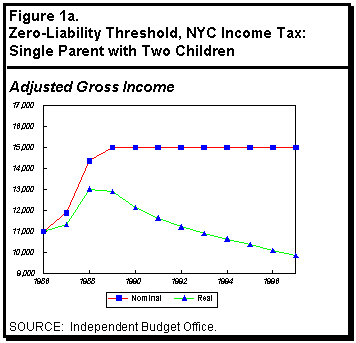
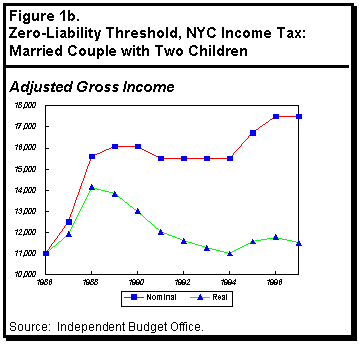
Single parent with two children. Creation of the household credit and three consecutive annual increases in the standard deduction caused the city's zero-liability threshold for a single parent with two children to rise from $11,000 in 1986 to $15,000 in 1989. In other words, a single parent with two children did not owe city income tax if his or her income, measured in nominal dollars, was less than $15,000. Despite recent increases in the standard deduction, the zero-liability threshold has remained constant since 1989 because the credit is not indexed in any way for inflation, and the value of the household credit is greatly reduced when gross income exceeds $15,000.
While the city's zero-liability threshold measured in nominal dollars has remained constant since 1989, it has declined in real terms. Measured in constant (1986) dollars, the threshold fell from $13,019 in 1988 to $9,861 in 1997. To illustrate the effect of inflation, consider a household with income just at the zero-liability threshold in 1989. The household would not have paid any city personal income tax in that year, but if their inflation-adjusted income had remained constant, their tax liability would have increased to $174 in 1997. Looked at another way, in order not to incur any city income tax liability, the household's real purchasing power would have had to decline 24 percent over the 1989-1997 period.
Married couple with two children. For a married couple with two children, the nominal increase in the city's zero-liability threshold since federal tax reform has been somewhat greater than for a single parent with two children-rising from $11,000 in 1986 to $17,500 in 1996 and 1997. The imposition of a 14 percent personal income tax surcharge caused the threshold to decline in 1991, while increases in the standard deduction and household credit caused the threshold to rise from 1994 to 1996.1
In real terms, the zero-liability threshold for married couples with children increased by 28 percent from 1986 to 1988. It then fell, and by 1994 the threshold was back to its 1986 level. Unlike the threshold for single parents, however, the zero-liability threshold for married couples has recently risen in real terms.
Comparing city, state, and federal zero-liability thresholds. In recent years, the city's zero-liability threshold has fallen significantly below the state and federal thresholds in both nominal and real terms. Figures 2a and 2b illustrate these thresholds for a single parent with two children.2 The state and federal thresholds have become significantly more generous over time due to the expansion of the federal earned income tax credit (EITC) to aid the working poor and the introduction in 1994 of a New York State EITC pegged to the value of the federal credit. (See below for a discussion of the EITC.) Moreover, the state and federal programs have remained more generous because, unlike the city's household credit, EITC benefits are adjusted for inflation. Unless the city acts to cut income taxes on the working poor, the gap between the city, state, and federal zero-liability thresholds will persist.3
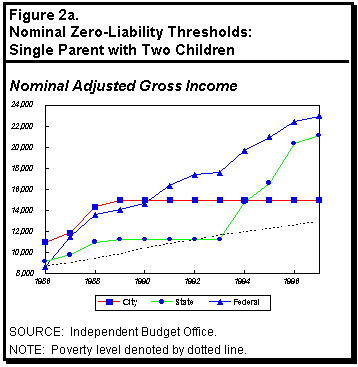

For both single parents and married couples with children, the federal zero-liability threshold has exceeded the city threshold in the 1990s, with the relative discrepancy increasing greatly in 1994, when the federal EITC became more generous above and beyond its adjustment for inflation. As a result, the federal zero-liability threshold increased in real terms as well.
The zero-liability threshold for the New York State income tax increased sharply in 1994, when the state instituted its own EITC. The amount of the state EITC that a taxpayer can claim is determined as a percentage of the federal credit, and from 1994 to 1996 this percentage nearly tripled. As a result, New York State's zero-liability threshold has risen rapidly, becoming much closer to the federal threshold in both nominal and real terms.
How Many New Yorkers are Affected?
IBO's analysis of a large sample of local tax returns shows that a significant number of city residents with incomes low enough to escape state and federal tax liability currently pay city income taxes. Furthermore, the number of households affected has risen sharply in recent years.4 (See lower panel of Figure 3.) The problem is particularly pronounced for single parents, both in terms of their growing share of all households that pay city (but not state) taxes and of their average tax liability. Despite recently enacted reductions in city personal income taxes under the StaR (School Tax Relief) program, IBO projects that the problem will persist.
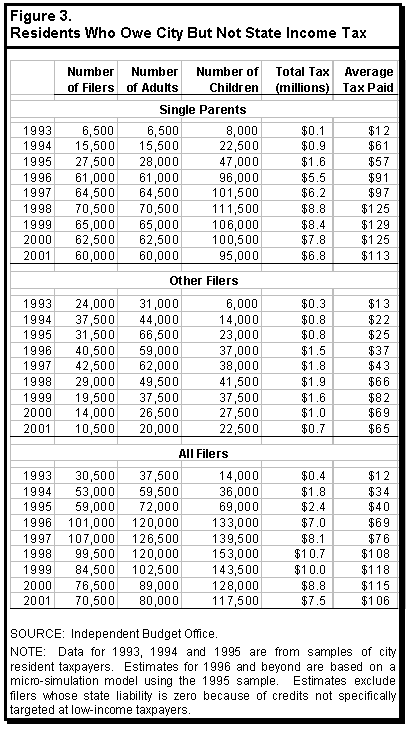
For the 1993 tax year-prior to the enactment of the state's EITC-IBO estimates that 30,500 city households had city tax liability but no state liability.5 (Because the federal zero-liability threshold exceeds the state threshold, households that do not pay state income tax also do not pay federal tax.) With the introduction of the state EITC for tax year 1994-initially at 7.5 percent of the federal credit-the number of city households with city liability but no state liability jumped to an estimated 53,000. For the 1995 tax year, when the state EITC increased to 10 percent of the federal credit, IBO finds that city households filed 59,000 tax returns on which no state but some city tax was owed.6 These households consisted of 141,000 city residents-including 69,000 children-and paid a total of $2.4 million in city personal income tax in 1995.
Using a sample of income tax returns and a micro-simulation model to estimate tax liabilities for 1996 and beyond, IBO projects that the number of households paying city but not state income taxes has increased sharply, nearly doubling over the past three years. IBO estimates that 99,500 households-comprising 273,000 individuals of whom 153,000 are children-will be affected in the current year. Their city personal income tax payments will total $10.7 million, over four times the total for 1995; while tax payments will average $108 per household, one quarter of these households will pay over $161 in city tax. Households paying city but not state income tax will account for 3.6 percent of 1998 returns and 8.5 percent of the children reported on all returns.
This increase in the number of affected households has been fueled by a rise in the number of single parents who pay city but not state income taxes. (See top panel of Figure 3.) In 1993, households headed by single parents accounted for 21 percent of all affected households. By 1998, however, single parents will comprise 71 percent of the households facing city liability but no state liability. Furthermore, the average liability of single parent filers ($125) will be almost double that of other affected taxpayers.
The number of city residents escaping state but not city taxes will not, however, continue to increase. In 1998, the STaR program will begin to phase in, easing income tax burdens for all city residents-including working poor New Yorkers-through a combined rate reduction and refundable credit. STaR will reduce the number of city residents who incur city but not state tax liability, but unless the city enacts additional measures to relieve the burden on low-income taxpayers, the number will still be quite large. By 2001, when the STaR program is fully implemented, 70,500 households-comprising 197,500 individuals of whom 117,500 are children-will owe no state tax but will pay $7.5 million in city personal income tax. Nearly 85 percent of affected households will be headed by single parents.
Similarly, if it were to be enacted, the mayor's proposal to institute a child care credit starting in 1998 would reduce tax burdens for many New Yorkers. Nevertheless, a significant number of city residents would still pay city but not state tax. In 2001, IBO projects that even with the proposed child care credit, 59,000 households would incur a total of $6.1 million in city income tax yet no state tax.
Policy Options
Criteria for evaluating low-income tax relief. Before discussing alternative methods of exempting households with no state or federal income tax liability from taxation by New York City, it is important to establish principles for evaluating low-income tax relief. Out of a wide range of possible criteria, IBO has focused on five desirable goals.
- The cost of tax relief should be reasonable.
- Benefits should be concentrated on poor and near-poor New Yorkers, particularly those in the target population.
- Disincentives to labor force participation should be minimized.
- Relief should not be costly to administer and should be readily available to intended beneficiaries.
- Tax relief should be long-lasting, not eroded by inflation over time.
There are a number of difficulties in adhering to these principles. Several of them involve value judgments. For example, costs that appear reasonable to one observer may seem prohibitive to another. Moreover, trade-offs are inevitable. Narrowly targeting benefits to the poorest households, for example, can discourage labor force participation of households with incomes just above the cutoff for the target population because the tax on each additional dollar of income above the cutoff (the marginal tax rate) would be high.7
Policy Options. Households that pay no state tax but incur some city liability-the target population of taxpayers to be removed from the rolls-generally benefit from one or more credits available on the state level, including an earned income tax credit and a child care credit. It is likely, therefore, that proposals involving a combination of reforms making city taxation of low-income New Yorkers correspond more closely to the state tax would be most effective at removing people from the tax rolls.
While the enactment of a child care credit in and of itself would eliminate city liability for only a small portion of the target population, our analysis indicates that instituting a city child care credit along with other tax reforms would significantly improve the efficiency of removing working poor taxpayers from the city's rolls. Accordingly, each of the following three policy options includes a city child care credit pegged to the existing state credit and phased out at higher income levels.8
Based on our criteria for evaluating low-income tax relief, IBO has selected three policy options used in conjunction with a child care credit to minimize the number of poor people paying city but not state income taxes:
- Indexing the city's existing household credit for inflation.
- Excluding from city tax liability those low-income residents who pay no state taxes.
- Providing an earned income tax credit (EITC).
As shown in Figure 4 on page 8, we have estimated the cost to the city of each of these options and their effectiveness in removing people in the target population from the city's tax rolls. (Figure 5 at the end of the brief restates this information in greater detail.)
Indexing the Existing Credit
Since 1987, low-income city residents have been able to take a household credit against their city personal income tax liability. The credit decreases as income rises and is available for childless individuals with incomes up to $12,500 and for other filers with incomes up to $22,500. For tax year 1998, childless individuals can receive a credit up to $15, while the maximum credit for all other filers is $30 times the number of deductions the filer is allowed to claim for federal purposes. Because neither the income brackets used in determining the credit nor the amount of the credit for each bracket is indexed for inflation, the value of the city's household credit has diminished over time.
Since low-income residents benefit from an inflation-adjusted EITC against their state tax liability, indexing the city's household credit could help address the growing discrepancy between the city and state zero-liability thresholds. IBO has modeled an indexed household credit in which the credit's income brackets are adjusted for inflation, while the dollar value of the credit available for each bracket is not changed.9 The brackets are kept at their real levels for 1988, the year in which the city's real zero-liability threshold peaked.
IBO projects that, in conjunction with a child care credit, indexing the household credit would reduce the number of households paying city but not state tax to 47,500, removing roughly half of the target population from the city tax rolls-52,000 out of 99,500 returns. The average city tax liability of filers remaining on the rolls is less than half that of the initial target population. The estimated cost of this option is just under $30 million for the 1998 tax year.
Assessment. Indexing the household credit is not a particularly effective solution to the problem because almost half of the target population would remain on the city's tax rolls. Moreover, the option isn't particularly efficient, because nearly three-quarters of the tax cut would benefit individuals outside the narrow target population. From a more positive perspective, indexing would benefit many other poor and near-poor working New Yorkers and keep inflation from eroding the credit's future value. Because a household credit is already in place, an indexed credit would be relatively easy for taxpayers to understand and use.
Low-Income Exclusion
An alternate way to provide relief to all working poor taxpayers is through a low-income exclusion. With an exclusion, taxpayers with incomes below a given threshold pay no tax. 10
It should be possible to tailor such an exclusion so as to target relief to the population of city residents who owe city tax but not state tax. To ensure that the benefits are concentrated on these taxpayers, a city zero-liability threshold could be established based on the taxpayer's state liability. If the state tax calculation (including any state-level credits targeted at low-income households) yields zero liability, then the taxpayer would also enter a zero as their city liability.
A major difficulty with an exclusion, whether based on an income threshold or a state tax liability threshold, is that when a taxpayer's income rises above the threshold, his or her city tax would jump substantially from zero-a notch effect. For example, a single parent with two children would see their 1998 city tax liability jump from zero to $256 as their income crossed the $21,531 mark and they incurred a dollar of state liability. The notch effect of a low-income exclusion can be avoided by structuring a gradual phase-in of city tax liability for incomes just above the no-tax floor, until liability reaches the amount that would have been incurred in the absence of the exclusion.
Although the liability phase-in helps mitigate the notch effect, it makes the design of an exclusion aimed at removing people from the city rolls who have no state liability much more complicated. The state zero-liability threshold and accompanying phase-in range is based on filing status, number of children, the value of available tax credits, and the tax tables themselves. As a result, rather than a single zero-liability threshold below which city liability would be excluded, a large number of different thresholds are needed to take into account the various possible combinations of the above items.
IBO has modeled a low-income exclusion option in which tax liability is zero for incomes below the taxpayer's state zero-liability threshold; for incomes above, city personal income tax increases by one dollar for every five dollars of income until liability is phased in fully-a 20 percent marginal tax rate for the phase-in range. As with the other options, a new city child care credit is included in the modeling. State zero-liability thresholds and corresponding phase-in ranges were identified for various combinations of filing status and number of children. If an exclusion were enacted, these thresholds would have to be set each year to reflect the value of the indexed EITC and any changes in standard deductions, exemptions, and state tax rates.
As indicated in Figure 4, the modeled low-income exclusion plus child care credit option would be highly effective-leaving only 8,000 out of 99,500 households in the target population paying city tax. Similarly, almost all of the city tax paid by the target population would be eliminated by the low-income exclusion, with the households remaining on the city tax rolls incurring a total of $500,000 in liability-$63 per return. A low-income exclusion would cost the city $25.8 million, less than the other options.
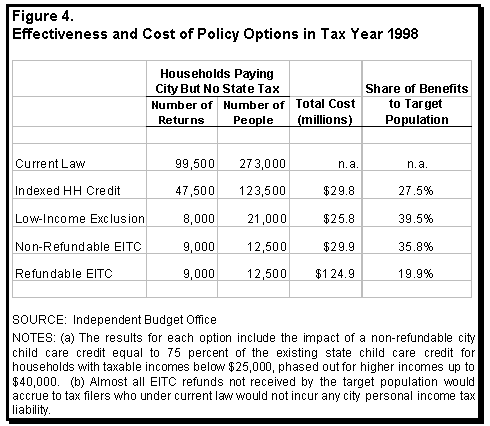
Assessment. Although effective at removing households from the city's tax rolls, this option is not very efficient, with 60 percent of its benefits flowing to taxpayers outside the target population. While in theory an exclusion should be highly efficient, two aspects of the option modeled here undercut the efficiency. First, the liability phase-in for incomes above the zero-liability thresholds, while helping to reduce the notch effect, yields benefits to households in the phase-in range who are not in the target population. Second, because the value of the state household credit and EITC were included when determining the zero-liability thresholds, households not taking advantage of these credits would be assigned an exclusion threshold higher than necessary. Many of the households not taking advantage of the state credits are poor or near poor; the fact that they owe state tax likely reflects difficulty on their part in dealing with the complexity of the tax system. Given the administrative complexity introduced when using an exclusion with a reduced notch effect, this option is somewhat less attractive than others despite its effectiveness in removing the target population from the city's tax rolls.
Earned Income Tax Credit
A third option for providing tax relief to working poor New Yorkers is to give households an earned income tax credit (EITC) against their city personal income tax liability. The credit would be particularly easy to provide if it were structured as a fixed percentage of the state credit, which itself is pegged to the federal EITC program.
Under the federal EITC program for the 1998 tax year, a household with two or more children receives a tax credit of 40 cents for every dollar of earned income up to $9,390, at which point the credit reaches its maximum value of $3,756. The credit remains at that level for incomes up to $12,260, then declines at a rate of roughly 21 cents for each additional dollar earned until it phases out entirely for incomes above $30,095. New York State's EITC is equal to 20 percent of the federal credit. Both the federal and New York State credits are indexed to adjust for inflation and both are refundable.
Earned income tax credits, and particularly refundable EITCs, provide low-income individuals with an incentive to increase their labor force participation. If the EITC is refundable, where a household's credit exceeds its income tax liability, the household receives a check for the difference. In the example of a household with two or more children, an additional dollar of earnings is supplemented by 48 cents in tax credits (40 cents from the federal government and 8 cents from the state), as long as the household's income is below $9,390. Although a refundable EITC would provide low-income New Yorkers with greater benefits and stronger work incentives, it would also be considerably more costly than a non-refundable EITC.
IBO has analyzed both a non-refundable and a refundable EITC, which we have modeled as 15 percent of the federal credit (or three-quarters of the state credit).11 As shown in Figure 4, the EITC option would leave only 9,000 households out of the target populations on the city's personal income tax rolls. City tax liability would be eliminated for more than nine out of ten New Yorkers in the target population-90,500 households comprising 260,500 individuals of whom 150,500 are children. Those remaining on the tax rolls would collectively pay just $63,000 in city income tax, an average of $7 per return.
The costs to the city of an EITC vary greatly depending on whether the credit is refundable. The cost of a non-refundable city EITC would be just under $30 million. Making the credit refundable, however, would bring the total cost of an EITC to $125 million.
Assessment. An EITC is a very effective means of removing the target population of households that escape state income taxes from the city's tax rolls. The efficiency of a non-refundable EITC in directing tax cuts to the target population is somewhat less than for the low-income exclusion option, but greater than for an indexed household credit; nearly 36 percent of the tax cut would be enjoyed by the target population. In contrast, for a refundable EITC, the vast majority of refunds-$81 million out of $95 million-would go to poor and near-poor households not in the target population.
A major advantage of an EITC is the positive incentives it provides for labor force participation, particularly where the credit is refundable. Moreover, if structured as a fixed percentage of the state credit, a city EITC would be very easy to administer and readily available to taxpayers. Finally, because EITC programs are indexed, tax relief would not be eroded by inflation over time. The major disadvantage of a refundable EITC would be its considerable cost-over four times as great as a non-refundable program.
Conclusion
Large numbers of working poor New Yorkers are burdened by city personal income tax liability, even though their incomes are low enough to escape state and federal income taxes. IBO projects that 99,500 households-made up of 273,000 individuals including 153,000 children-will pay city but not state income taxes in 1998. The problem is particularly severe for single parents, who account for over 70 percent of affected households. Although the recently enacted STaR program will ease personal income tax burdens for all city residents over the next few years, IBO estimates that 70,500 low-income households will still pay city but not state income taxes when the STaR program is fully implemented in 2001.
Although all three policy options IBO has developed to address the problem have merit, our analysis suggests that a non-refundable earned income tax credit, coupled with a local child care credit, would work particularly well. Both a low-income exclusion and a non-refundable EITC would remove the vast majority of affected households from the city's tax rolls, concentrate between 36 percent and 40 percent of benefits on the target population, cost less than $30 million, and provide long-lasting tax relief. Unlike a low-income exclusion, however, an EITC would be easy to administer and easy for taxpayers to use because it would piggyback on the already existing state credit.
As with any reform that cuts income taxes on the working poor, a non-refundable EITC would reduce disincentives for labor market participation. If the EITC were made refundable, however, incentives for labor market participation would be far stronger because households without pre-credit liability would receive more money in the form of a refunded credit as their income from work increased. Making the credit refundable, however, would increase the annual cost of the EITC option fourfold-from $30 million to $125 million.
Finally, the options IBO has developed are intended to reduce the number of low-income residents who pay city but no state income taxes, a problem caused in large part by the impact of inflation over time on the city's household credit. This points to a more general problem in the city tax system-the absence of automatic indexing. Although the reforms IBO has modeled have not attempted to address this underlying issue, it too deserves serious consideration.
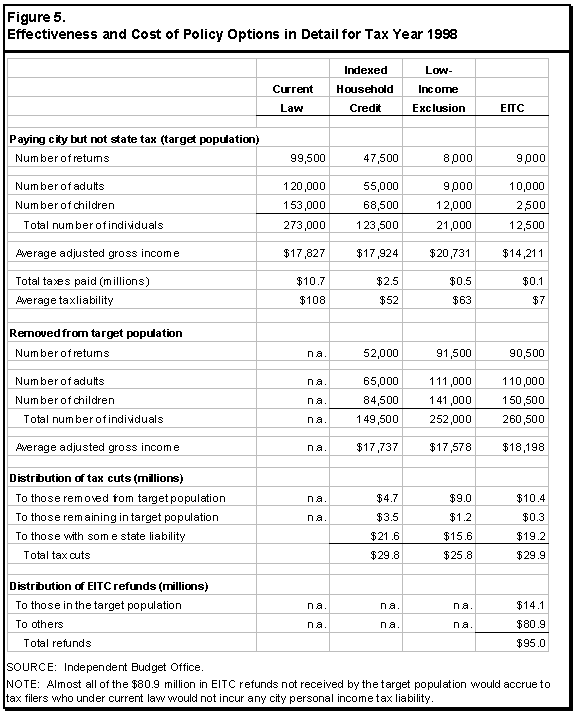
Footnotes
1 The tax surcharge also applied to single parents but it had no effect on their zero-liability threshold. 2 Some low-income taxpayers pay no federal or state taxes even when their incomes are above the thresholds reported here because they are able to take a child and dependent care credit against their federal and state taxes. The state's child care credit is pegged to the federal credit and has become more generous in recent years, further increasing the discrepancy between the city and state thresholds for many households. 3 Nevertheless, the city threshold-along with the state and federal thresholds-has remained above the federally defined poverty level. For 1997, the city's zero-tax liability threshold for a single parent with two children was 16 percent above the federal poverty level. The poverty level, however, is defined with respect to average consumer prices nationwide which are substantially lower than in New York City. 4 The analysis is based on samples of 1993, 1994, and 1995 New York State tax returns, which for the 1995 sample includes more than 45,000 returns subject to the city's tax on personal income. The Personal Income Tax Study File sample is prepared annually (1995 is the latest available) by the Office of Tax Policy Analysis of the New York State Department of Taxation and Finance. 5 Our estimates of the number of taxpayers with city liability but no state liability used throughout this fiscal brief exclude taxpayers whose state liability is reduced to zero through the use of state tax credits not targeted at lower income taxpayers. Some of the credits included in this category are the solar energy credit, the investment credit, and the economic development zone credit. 6 Another 14,000 households would not have incurred state tax had they taken advantage of the EITC available to them. These households are not included in the data reported in Figure 3. 7 For a fuller discussion of criteria for evaluating tax relief, see Steven D. Gold and David S. Liebschutz, State Tax Relief for the Poor (Albany, N.Y.: The Nelson A. Rockefeller Institute of Government, 1996), pp. 19-28. 8 The non-refundable city child care credit IBO has modeled equals 75 percent of the existing state credit for households with taxable incomes below $25,000. For households with higher taxable incomes, the applicable percentage gradually diminishes to zero at $40,000 of taxable income. Compared to the mayor's proposal, this child care credit would be more generous for low-income families and less generous for high-income households. Our model assumes that filers who claim the state child care credit would also take the city credit. 9 Indexing the credit along with the brackets added considerably to the cost of the proposal but did little to remove additional households in the target population from the city's tax rolls. 10 Prior to 1987, New York City had such an exclusion, with the zero-liability threshold set to $11,000 of AGI ($5,500 for individuals with no children). These thresholds were sufficiently high so that about 15 percent of filers who otherwise would have owed city income tax were excluded. The city thresholds were also well above the state's parallel zero-liability thresholds of $8,000 and $4,000. 11 A city EITC would be somewhat more effective but also more costly than our estimates suggest if the share of eligible filers taking advantage of an EITC were greater than what we have assumed. IBO's estimates are based on the share of eligible taxpayers who took advantage of the state EITC in 1995, the second year of the credit's existence. It is likely that in subsequent years, as the credit's value doubled (from 10 to 20 percent of the federal credit) and its familiarity to taxpayers increased, a larger share of eligible households took the credit.
This fiscal brief was prepared by IBO's Economic Analysis Division. Principal authors were George V. Sweeting, senior economist, Michael Jacobs, senior economist, and Ronnie Lowenstein, chief economist and deputy director Independent Budget Office
110 William Street, 14th Floor
New York, New York 10038
(212)442-0632 / 442-0350 (fax)
E-mail Address: ibo@ibo.nyc.ny.us
Douglas A. Criscitello, Director